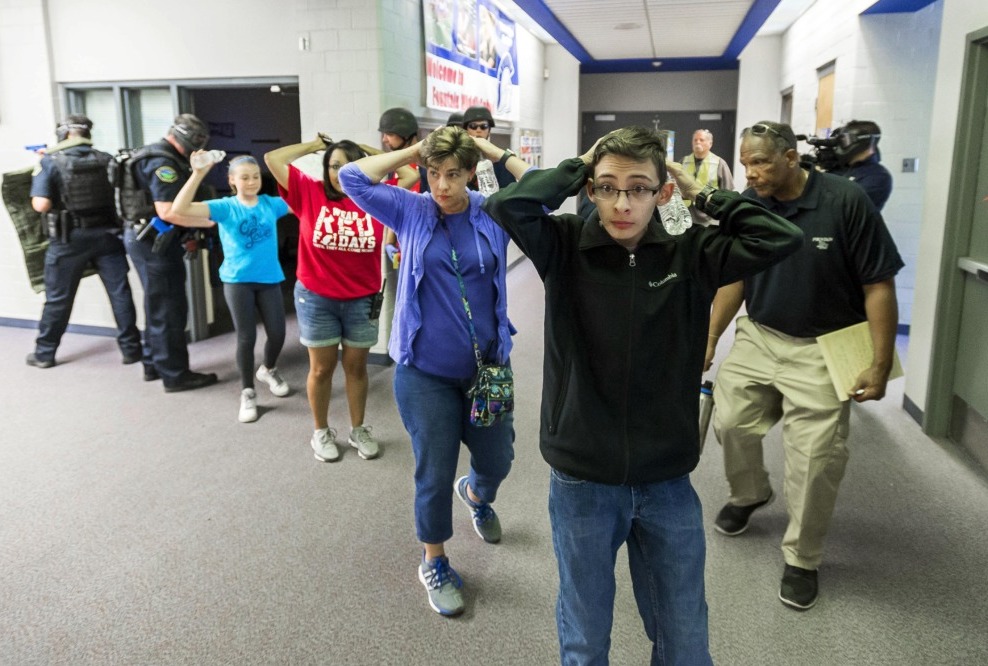Lockdown drills aimed at preparing students to protect themselves from school shooters do more to stir kids’ anxiety than their sense of protection, argues Dr. Annie Andrews, a South Carolina mother, pediatrician and firearm injury researcher.

Courtesy of Annie Andrews
Annie Andrews
“Our children do not benefit from participating in these drills,” said former congressional candidate Andrews, also co-founder of Their Future. Our Vote. “Children deserve to feel safe in their schools.”
Among those countering that viewpoint is Alex Piquero, a University of Miami criminologist and former director of the federal Bureau of Justice Statistics.
“We are, unfortunately, living in a world where we just have to plan for school shootings and hope that they never happen,” said Piquero, a former editor of the Journal of Quantitative Criminology. “The key is how you do the drills and making sure that you give kids instruction in a way that they can respond to positively and that doesn’t affect them adversely.”
A record 188 school shootings occurred during the 2021-22 academic year alone according to the most recent federal data. And since 1999’s Columbine High School gun-slayings of 12 students and one teacher — the two shooters died by suicide — more than 357,000 students have experienced gun violence at school since 1999, according to data The Washington Post collected and updated in October 2023.
As those numbers have climbed, so have adopted mandatory lockdown drills, with roughly 95 percent of kindergarten through 12th-grade schools nationwide now training children and faculty on what to do if there’s an active shooter inside the building or on campus grounds.
Among students and educators, some support and some oppose the drills.
Research: Educators, students have divided opinions on drills
In the 30 schools of a Central New York school district with more than 21,000 students and 3,500 teachers, support staffers and administrators found that students who participated in multiple lockdown drills and training reported being less fearful over time, according to a study published in 2022 in Criminal Justice Policy Review. It was based on data from 288 lockdown drills from 2018 through 2022 in that district, which those State University of New York at Oswego researchers did not name.
Conversely, a study by Everytown For Gun Safety and Georgia Institute of Technology, updated in February 2023 found that, after going through those drills, there was a 42% increase in anxiety and stress among students at 114 schools spanning 33 states; a 39% spike in depression; a 23% rise in health concerns; and a 22% surge in fear of death. The study compared changes in social media conversations among those students 90 days before and 90 days after active shooter drills.

Courtesy of Sarah Burd-Sharps
Sarah Burd-Sharps
“We’re just traumatizing another generation of American schoolchildren,” said Sarah Burd-Sharps, Everytown’s senior director of research. “And there’s almost no research that confirms the value of these shooter drills either for preventing school shootings or for protecting the school community.”
The drills do more harm than good, said Ibti Checko, a junior at Hume-Fogg High School in Nashville, Tennessee. “All they do is cause anxiety and make us feel like a school shooting is inevitable.”
Until recently, her school’s drills happened without warning, leaving her and her classmates sometimes wondering if they were in real danger or not.
“When they don’t give you a heads up about what’s going to happen, it makes it feel that much more real and your body automatically just goes into fight or flight mode,” said Checko, whose school now requires teachers to tell the students when a drill is scheduled. Also, that day is announced over the school’s intercom.
Makena Reno, a senior at Blue Valley Southwest High School in Overland Park, Kansas, offered a different viewpoint: “My school does a really good job of making sure that students know that this is just a drill and that nothing is actually happening that they need to be concerned about.
“It’s helpful for students to have precautions and measures for safety in case something were to happen and it helps to provide comfort in general.”
Because school shootings are relatively rare, despite the recent years’ surge, there has been no rigorous testing of whether mandatory lockdown drills have improved students’ chances of survival during an actual incident, argue University of Massachusetts Chan Medical School pediatrician Dr. Mary Miotto, and Robin Cogan, a New Jersey school nurse and Rutgers University professor.
Also, a lack of federal standards for drills has resulted in widely varying methods vary from district to district and state to state, co-wrote Miotto and Cogan, her state’s representative to the National Association of School Nurses, in a May 2023 commentary in the New England Journal of Medicine. They called for evidence proving the need for such drills.
Parents push for drills that don’t fuel fear
In Florida’s Miami-Dade County, this year’s active shooter simulations involved bandaging children and covering them in makeup resembling gunshot wounds, while police officers posing as school shooters ran through halls and classrooms. In North Carolina, parents protested a Sun Valley High School lockdown drill that prompted their children, who had no advance notice of it, to send what they thought were final messages to their loved ones.

Courtesy of Jaclyn Schildkraut
Jaclyn Schildkrau
Those cases are perfect examples of what not to do, said Jaclyn Schildkraut, executive director of the Regional Gun Violence Research Consortium at the Rockefeller Institute of Government.
“If you’re coming in and simulating a shooting, absolutely nobody in their right mind should be exposing kids to that,” said Schildkraut, lead author of that Central New York school district analysis. “But when drills are being done in accordance with best practices, ones that prohibit that kind of potential trauma, then, they serve a very important function in schools and prepare children without scaring them.”
Drills should involve locking classroom, auditorium or other doors; moving students out of sight; and requiring students to remain quiet, according to guidelines issued in May 2021 by the National Association of School Psychologists, National Association of School Resource Officers and Safe and Sound Schools. The guidance aimed to address the “growing concern over the unintended harm caused by conducting drills inappropriately,” those organizations wrote.
These were among the recommended steps for safe, effective and appropriate drills:
- Drills should be tailored to students’ developmental levels and physical abilities and consider their prior traumatic experiences, special needs and temperaments.
- All drills must ensure the physical and psychological safety of students, who also must understand the information provided and be proficient in following the steps of a drill.
- School-employed mental health professionals should be involved in every stage of preparation.
- Student participation should never be mandatory.
- Parental consent should always be obtained.
- Establish a long-term, follow-up plan to support sustainability that includes assessing ongoing or changing preparedness training needs.

Courtesy of Melissa Reeves
Melissa Reeves
Those best practices stemmed from an understanding that schools need to be prepared for active assailants and that many drill programs were insufficient, if not outright bad, said psychologist Melissa Reeves, a guidelines co-author, past president of the National Association of School Psychologists and former chair of the association’s National School Safety and Crisis Response Committee.
“Schools definitely need to be prepared,” Reeves said. “But we are all adamant that you should never do an unannounced armed assailant drill and that students should not be involved or mandated to be involved if you do.”
Schools following those associations’ protocols during a mass shooting experienced 59% fewer casualties than schools that did not follow them, according to a study that the Journal of School Violence published in 2022, analyzing 498 mass shootings across 561 sites between 1966 and 2019.
Following school psychologists’ drill guidelines
Superintendent Michael Bennett, of the Greenville Central School District in Greene County, New York, said he followed the 2021 guidance to the letter as he implemented drills districtwide.
“We do four drills a year, from K through 12, and I think we’re doing the right thing by our kids by doing them in such a way that we’re educating and preparing them at the same time,” Bennett said.

Courtesy of Greenville Central School District
Michael Bennett
At the start of the school year, teachers in his district are charged with informing students about lockdown drills, their importance and how they work. Teachers locate for students what’s called the “lockdown corner,” the spot in a classroom where students hunker down during drills, staying quiet and out of sight through classroom windows. Students get advance notification of the drills and are repeatedly reassured that it is, in fact, a drill that is occurring.
“It’s hard to create muscle memory for a situation like a school shooting,” Bennett said. ”But as much as you can practice the protocols and understand the why behind them, then the better off you’re going to be when you find yourself in that situation.”
[Related: Doctor decries gun violence after school shooting near miss]
His district’s additional safety measures include automatic locks on every classroom door that keep them closed during a lockdown and require an ID card to unlock; blue safety lights and strobes alerting everyone of a lockdown; and automated messaging on billboards and other exterior signage that displays information about any drill or active-shooter lockdown. Teachers and administrators also work with police to plan and implement the lockdown drills.
“It’s not just about having the conversation with the kids and then going into the practice lockdown,” Bennett said. “It’s debriefing with the professionals and trying to figure out what we’ve learned or areas in which we need to improve.”
“If we have to do it,” said researcher Schildkraut, of that gun violence consortium, “let’s make sure we’re doing it right. Because, at the end of the day, what drills are teaching people is situational awareness and decision-making in stressful situations, and that’s a life skill anybody can benefit from.”
***
Isidoro Rodriguez is a Brooklyn, New York-based reporter who covers police reform and misconduct, juvenile justice, gun violence and sex work.





























